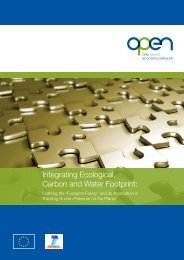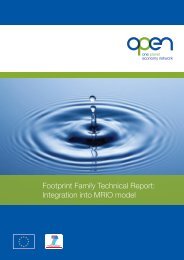OPEN: EU Scenario Storylines Report: - One Planet Economy Network
OPEN: EU Scenario Storylines Report: - One Planet Economy Network
OPEN: EU Scenario Storylines Report: - One Planet Economy Network
You also want an ePaper? Increase the reach of your titles
YUMPU automatically turns print PDFs into web optimized ePapers that Google loves.
past 40 years, overall environmental impact (measured by the Footprint family of<br />
indicators) is low, due to the substantial decline in resource inputs for farming and the<br />
dramatic decrease in meat and animal product consumption. There has been a gradual<br />
move from conventional agriculture and (industrial) livestock operation towards plantbased,<br />
labour-intensive and organic agriculture. The share of organic farming is nearly<br />
95%. Thanks to the spread of permaculture systems, wastes are turned into resources,<br />
productivity and yields are high, and natural environments have been restored. GMO<br />
crops are no longer used or consumed in the <strong>EU</strong>. GMO crop import bans have resulted in<br />
a significant global reduction in the use of GMOs, which in turn has enhanced crop<br />
biodiversity and food security.<br />
At the international level, global, peaceful agreements ensure convergence of<br />
emissions and on the sustainable and equitable use of resources. A new<br />
international consensus was reached to ensure that international trade would contribute<br />
to a global <strong>One</strong> <strong>Planet</strong> <strong>Economy</strong>. The regime is built on three guiding principles: (1) trade<br />
based on environmental competitive advantage; (2) fair trade; (3) localisation 15 . No trade<br />
barriers exist for best available technologies in terms of resource and energy efficiency.<br />
As a result of large-scale dematerialisation, the <strong>EU</strong> was able to diminish its overall<br />
dependence on imports of goods and services to become more self-contained.<br />
<strong>EU</strong>ROPE’S POLICY MIX TO A ONE PLANET ECONOMY BY 2050<br />
Broad economic policies<br />
� Economic reform. Given the strong societal drive to shift into a quality-driven<br />
development paradigm, <strong>EU</strong> economic policy transitioned to a Beyond GDP model.<br />
This was aided by the early adoption (2012) of sustainability indicators for<br />
monitoring economic progress. To support this, Europe embarked on a broad<br />
policy of ensuring that the true social and environmental costs of producing and<br />
consuming all goods and services are reflected in prices.<br />
� Monetary policy reform. European monetary policy is strongly aligned with the<br />
objectives of the <strong>One</strong> <strong>Planet</strong> <strong>Economy</strong>. The European Central Bank and the<br />
National Banks took on a role designed to steer the European economy towards a<br />
path consistent with the <strong>One</strong> <strong>Planet</strong> economy goals.<br />
� R&D investment policy. As in scenario 3, great emphasis was placed on efforts<br />
to compensate for the lag in technological innovation. Building on policy<br />
recommendations existing in 2011, the <strong>EU</strong> mandated (effective 2015) that<br />
Member States invest in R&D the equivalent of 8% GDP each year and increase<br />
total R&D energy subsidies at a rate of 7% every 5 years – percentages that are<br />
slightly lower than in scenario 3.<br />
� Coordination of innovation-technology agencies. A coordination framework<br />
was established early on to enhance <strong>EU</strong>-Member State collaboration under the<br />
Environmental Technologies Action Plan (ETAP), the Competitiveness and<br />
Innovation Framework Programme (CIP) and other programmes fostering ecoinnovation.<br />
Eco-innovation was focused on ―low hanging fruit‖ sectors where large<br />
15 Economic localisation actively favours more local production and investment whenever it is reasonable and<br />
conveniently possible. With a focus on co-operation for the best, rather than competition for the cheapest,<br />
localisation aims to rebuild sustainable national and local economies worldwide. Depending on the size of the<br />
country, ―local‖ can both refer to a country, which may aim for increased self-reliance within its own borders,<br />
or to a grouping of smaller, neighbouring countries. For a more detailed account of localisation, see for<br />
example Woodin and Lucas (2004).<br />
Page 41 of 57





